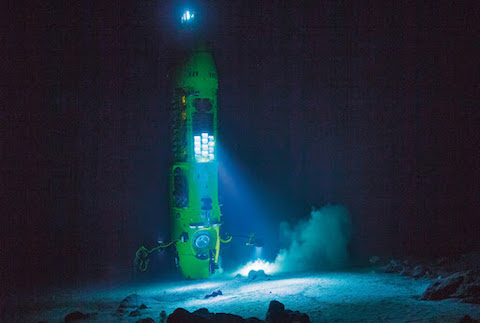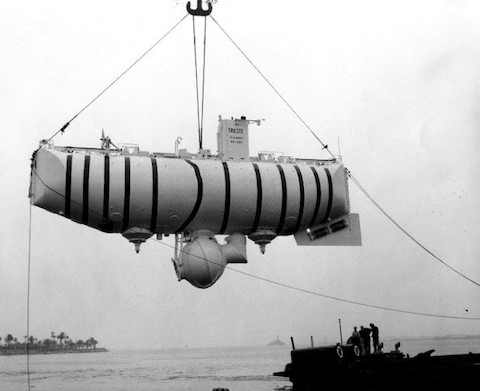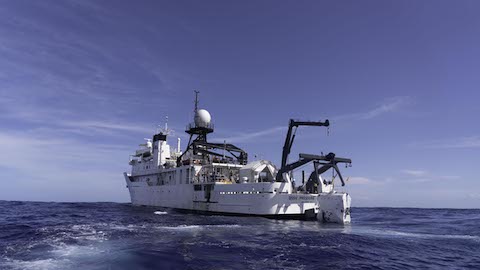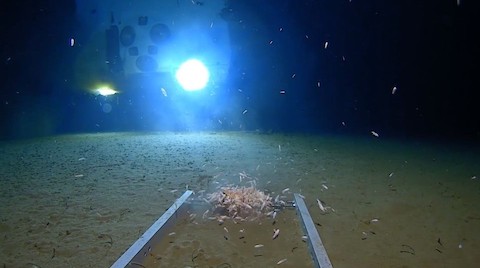
The first humans to explore it were a Swiss oceanographer and U.S. Navy Lieutenant. They built a special deepwater submarine called a bathyscaphe, and in 1960, headed for the bottom.
It took them 3 hours to reach the western pool of Challenger Deep at 35,000 feet. But they stirred up so much sediment, they couldn’t see anything.
That, and a worrisome crack in a window, cut their trip short. After 20 minutes, they jettisoned their ballast and began their 2-hour trip to the surface.
The next visit came 50 years later, when film director James Cameron co-designed his own ultradeep submersible and captained it solo into the deeper Eastern pool, at 35,800 feet.
He spent 2 hours motoring slowly around the bottom, taking photos and video, but didn’t see any creature longer than 1 inch.
Recently, explorer Victor Vescovo piloted his craft slightly deeper than Cameron, now holding the world record. His scientific team then made a few more trips to the bottom, discovering a new species and gathering samples.
They found small crustaceans with high concentrations of chemicals banned in the 1970’s. And, a plastic candy wrapper.
A reminder that, even in places where humans can scarcely visit, our impact can be seen.
Background
Synopsis: Challenger Deep is deeper than Mount Everest is tall. Though thousands of people have summited Everest, just over a dozen have visited Earth’s deepest deep. But maybe you can visit soon—for a cool $750,000!
- Manned exploration of Challenger Deep began in 1960 with the Trieste, a “bathyscape” designed for the voyage by Swiss scientist Jacques Piccard and his father Auguste.
- A spherical pressure vessel about 7 ft (2.16 m) in diameter served as the crew compartment, which was suspended beneath a buoyancy tank that was 60 ft (18.4 m) long with 5 in (12.7 cm) steel walls to withstand the intense pressure.
- U.S. Navy Lieutenant Don Walsh accompanied oceanographer Jacques Piccard for a 5-hour trip to around 35,800 ft (10,911 m), landing in the westernmost pool of the Challenger Deep.
- They spent about 20 minutes in the midst of the sediment cloud stirred up by their landing. Concerned over a crack in the outer window and the lack of visibility, they decided to ascend to their support ships, which took 3 hours and 15 minutes.

- It was 52 years later when the next manned expedition to the floor of Challenger Deep occurred, this time to the easternmost of the three pools.
- Canadian film director James Cameron solo-piloted the deep submergence vehicle DSV Deepsea Challenger, a vertical submersible that he helped to design with an Australian company.
- The descent took 2 hours and 36 minutes. At 35,787 ft (10,908 m), Cameron landed on a “gelatinous flat plain.” He later described the landscape as “lunar” and “desolate.”
- He motored across the flat toward the slope for a couple of hours without seeing any organisms over 1 inch (2.54 cm) long. Discovering a hydraulic fluid leak, he started his 90-minute ascent.
- After the adventure, he donated the Deepsea Challenger it to the Woods Hole Oceanographic Institution.

- Seven years after Cameron’s solo trip, in 2019, explorer Victor Vescovo piloted a state-of-the-art Triton submarine called DSV Limiting Factor to the eastern pool of Challenger Deep.
- He then piloted the submarine twice more to the eastern pool to a maximum depth of 35,843 ft (10,925 m) ±13 ft (4 m).
- Although apparently deeper than Cameron’s 2012 expedition, both expeditions landed on the flat floor of the eastern pool, so it is possible calculations were off for one of the depths.
- On the Limiting Factor’s fourth dive, the sub designer Patrick Lahey piloted it to the shallower central pool.
- In mid-2020 six more crewed landings occurred during Vescovo’s Ring of Fire Expedition.
- The first of these dives included the first woman to walk in space in October 1984, former U.S. Astronaut Kathryn Sullivan. The crew’s day ended with a call to astronauts in the International Space Station 254 miles above Earth.
- Another dive included mountaineer Vanessa O’Brien, and yet another included Kelly Walsh, the son of the Trieste’s pilot, Don Walsh.
- In total, 15 people have landed on the floor of Challenger Deep.
- Vescovo has reportedly put the DSV Limiting Factor up for sale, and a London firm is advertising the exclusive experience of dives on future expeditions for $750,000 a person.
- What did these expeditions find in the trench?
- Conditions in deep-sea trenches are extreme—complete darkness, high pressure, and near freezing water—so life forms and the food web are limited. Some trench organisms rely on chemosynthesis of methane or sulfur.
- Deep in the trench, huge single-celled xenophyophores, shrimplike amphipods, and bizarre translucent holothurians (sea cucumbers) are the most common life forms.
- The small, pink, scaleless Mariana snailfish is the top predator, thriving at around 26,200 ft (8000 m).
- More than 200 microbes were identified in mud from the floor of the deep. Microbial mats have been identified near hydrogen and methane seeps in the trench.
- Pollutants that were banned in the 1970’s have been found in high concentrations in the fatty tissues of the shrimplike amphipods from the Challenger Deep.
- When he landed in the eastern pool of the Challenger Deep in May 2019, Victor Vescovo noticed something familiar out his porthole: plastic waste resembling a candy wrapper had arrived before him at the deepest point in the ocean.

- The United States has jurisdiction over the Mariana Trench because Guam is a U.S. territory and the 15 nearby Northern Mariana Islands are a U.S. commonwealth.
- In January 2009, President George W. Bush established the Mariana Trench Marine National Monument as a protected marine reserve. The entire reserve is underwater.
- The 44-mi-wide (71 km) zone extends for 1100 mi (1770 km) to include 95,216 mi2 (246,610 km2) of seafloor along the trench, including nearby volcanoes and mud volcanoes.
- The protected area ends just east of Challenger Deep.
